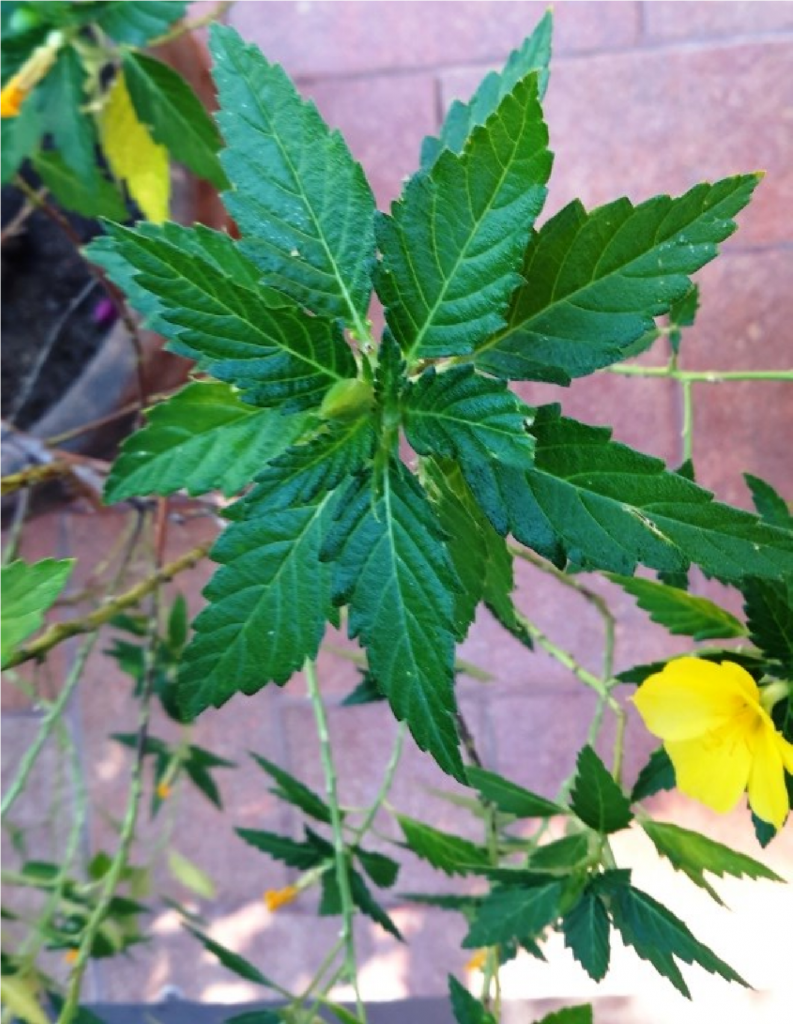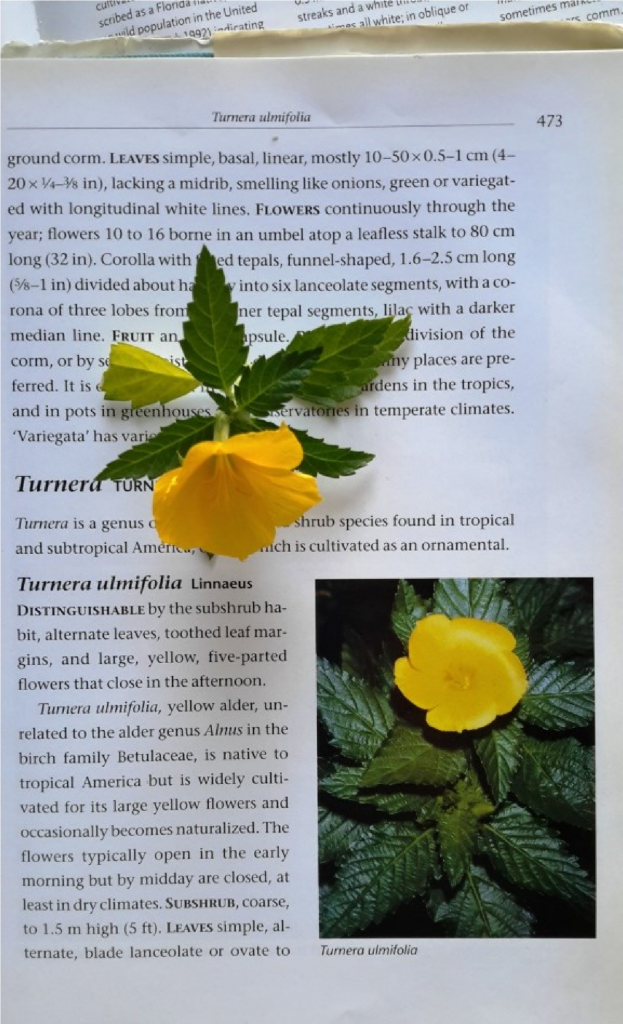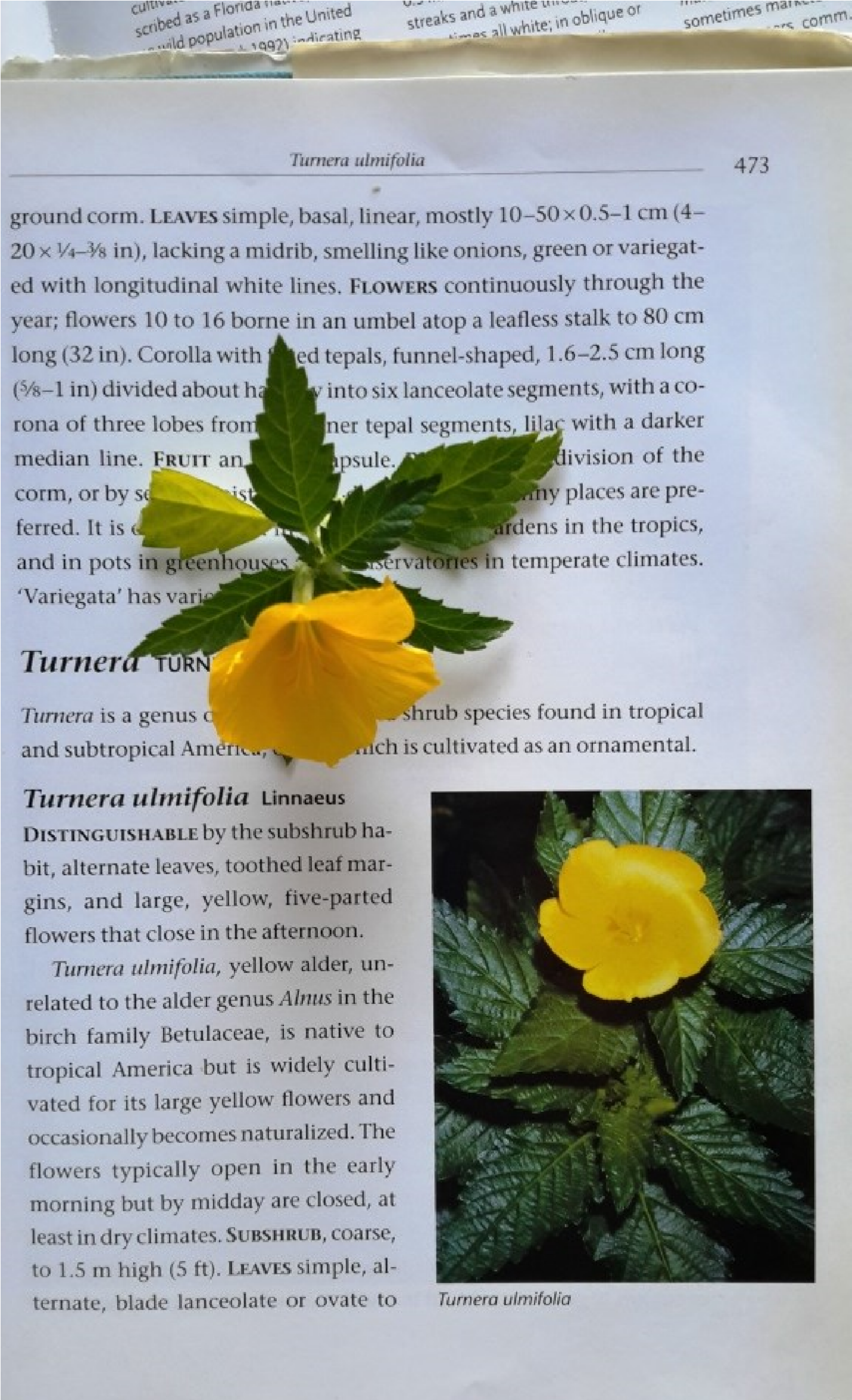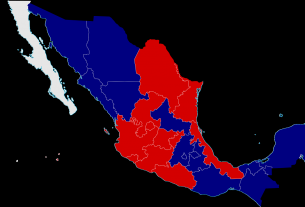By Tommy Clarkson from the February 2019 Edition
Family Turneracea
Also known as Mexican Holly, Damiana, Damiana Aphrodisiaca, Damiana Herb, Damiana Leaf, Mexican
Damiana, Mizibcoc, Old Woman’s Broom and Oreganillo
(I encourage you to be seated and holding onto something secure as you read the following – quite possibly – most shocking of surprises. But I have been known to be wrong! Hold on there. Deep breaths. Try to get a grip, as I know this is a startling and shattering revelation, but, sadly, it is true. You see, some botanists of authority might assert this to be the very closely related Turnera ulmiflora. They are very similar. Hence, I’m unsure as to what I should call it with any manner of assuredness. Beyond that, I really should probably respectfully ask you to wait on my next book “The Medicinal Jungle” to learn of all the intriguing, possible, homeopathic, aspects of about this perennial shrub . . . or, perhaps more accurately, subshrub. But, given my impatience to share these Nifty Nuggets of
Knowledge, I won’t do that!)

According to The Plant List a collaborative effort between the Royal Botanic Gardens, Kew Gardens and Missouri Botanical Garden – the genus Turnera is in the family Passifloraceae in the major group Angiosperms (Flowering plants) and includes 218 scientific plant names of species rank. (Take notes, this might be on the test!)
While they share the same, common name, the similarly named Butterfly Bush (Clerodendrum myricoides) and (Buddleja davidii) are altogether different species. This particular wild shrub grows in southwestern Texas, Mexico, Central America, the West Indies and at least one source contends Africa, as well. Its leaves and stems have been used, purportedly, for medicinal applications since the ancient Mayan civilization.
It is used in traditional medicine as an anti-cough and diuretic. Here, in Mexican culture, I understand that it is used for gastrointestinal disorders. And while not sure what I think of the test subjects and their response as it relates to me, studies with rats appear to support the folk reputation that Turnera diffusa is an effective sexual stimulant.
It is on the US Food and Drug Administration’s (FDA) list for use as a food flavoring. That said, however, it does contain low levels of cyanide-like compounds so excessive doses could be dangerous.

It is used in traditional medicine as an anti-cough and diuretic. Here, in Mexican culture, I understand that it is used for gastrointestinal disorders. And while not sure what I think of the test subjects and their response as it relates to me, studies with rats appear to support the folk reputation that Turnera diffusa is an effective sexual stimulant.
It is on the US Food and Drug Administration’s (FDA) list for use as a food flavoring. That said, however, it does contain low levels of cyanide-like compounds so excessive doses could be dangerous.
(Some might just want to skim this paragraph!) But for those with intense, inquisitive minds, Science Direct says its leaves contain as much as 1% volatile oil consisting of 1,8-cineole, pcymene, alpha and beta-pinene, thymol, alpha-copaene, and calamine. Further research has indicated the presence of caryophyllene oxide, caryophyllene, delta-cadinene, elemene as well as damiana include albuminoids, alpha-copaene, alpha-pinene, arbutin, barterin, beta-sitosterol, calamenene, caoutchouc, chlorophyll, cymene, cymol, damianin, essential oil, gammacadinene, gonzalitosin-i, hexacosanol-1, luteolin, quinovopyranosides, tannins, tetraphyllin b, thymol, triacontane, and triBut beyond this more “questionably recreational” application, it has also been used to treat stomach complaints such as dyspepsia, diarrhea, and constipation, as well as to help resolve the negative symptoms of menopause and PMS. Additionally, from sources outside of my tropical plant resource books, on MedicineNet.com, I read that, “Turnera diffusa is a natural herbal supplement. The exact (chemical) mechanism of how Turnera diffusa works is not known. But it is believed to have stimulant, antidepressant, mood improving, libido enhancing, euphoric, and nervous system restorative properties.” Suffice it to say that I strongly advise one to consult their doctor before using any of the Turnera plants, in any condition, manner or form.
(“Sheesh Tommy, I’m just interested in it as a garden addition!”) OK. With its subtly, sweet-smelling and attractive flowers, the Butterfly Bush likes well-draining soil, in full sun, being kept consistently moist particularly during hot, dry weather, is fastgrowing, and can reach six to ten feet (1.83-3.05) meters) in two years.
Now about those horny rats . . . .
The full edition or view it online
—
Tommy Clarkson is a bit of a renaissance man. He’s lived and worked in locales as disparate as the 1.2 square mile island of Kwajalein to war-torn Iraq, from aboard he and Patty’s boat berthed out of Sea Bright, NJ to Thailand, Germany, Hawaii and Viet Nam; He’s taught classes and courses on creative writing and mass communications from the elementary grades to graduate level; He’s spoken to a wide array of meetings, conferences and assemblages on topics as varied as Buddhism, strategic marketing and tropical plants; In the latter category he and Patty’s recently book, “The Civilized Jungle” – written for the lay gardener – has been heralded as “the best tropical plant book in the last ten years”; And, according to Trip Advisor, their spectacular tropical creation – Ola Brisa Gardens – is the “Number One Tour destination in Manzanillo”.




